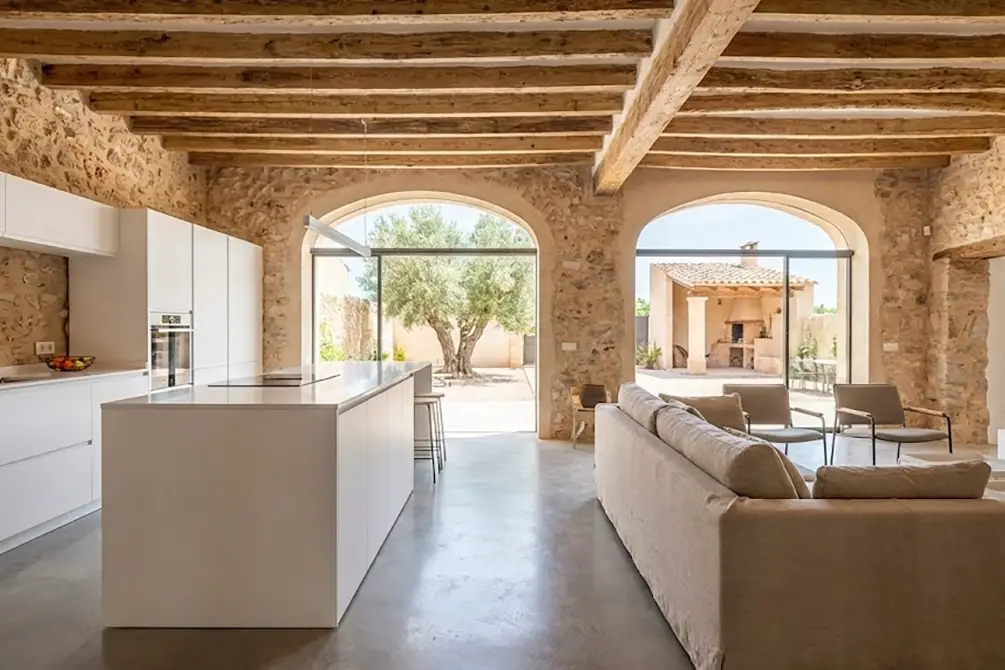Building on sloping land presents unique challenges and opportunities. It is crucial to carefully evaluate the advantages and disadvantages to ensure a successful construction process. Additionally, choosing the right construction techniques plays a fundamental role in the final outcome of the project.
Advantages and Disadvantages of Building on Sloping Plots
Advantages of building on sloping plots:
- Excitement and challenge: The irregular topography of a sloping plot sparks the creativity of architects and designers. Each project becomes a unique challenge, where innovation and adaptability are key.
- Maximising views: Slopes offer the opportunity to make the most of panoramic views, whether of natural landscapes, cities, or surrounding architectural elements. The house becomes a privileged viewpoint.
- Indoor-outdoor fusion: The integration of the home with the natural environment becomes more fluid on sloping land. Terraces, balconies, and large windows allow for a visual and spatial connection with the landscape, creating a feeling of spaciousness and harmony.
- Originality and exclusivity: Homes on sloping plots often stand out for their unique and original design. Adapting to the topography gives rise to unconventional shapes and volumes, creating exclusive and personalised architecture.
Disadvantages of building on sloping plots:
- Higher cost: Construction on sloping land is usually more expensive than on flat land. The need for earthworks, special foundations, and more complex structures increases the project budget.
- Technical complexity: Design and construction on slopes require specialised technical knowledge and rigorous planning. It is essential to have experienced professionals to guarantee the stability, safety, and functionality of the home.
- Access and services: Access to sloping plots can be more complicated, which can hinder the transport of materials and the connection to basic services such as water, electricity, and sewage.
Construction Techniques for Sloping Plots
Construction on stilts
The technique of building on stilts allows for adaptation to the slope of the land, creating a feeling of lightness and elevation in the structure. This strategy can optimise views and minimise excavation of the soil.
Construction with retaining walls
Retaining walls are essential on sloping land, as they help to level construction areas and prevent problems of soil slippage. In addition, they offer the possibility of creating terraces or stepped gardens, adding aesthetic and functional value to the construction.
Local Regulations and Restrictions
When building on sloping land, it is essential to consider local regulations that may affect the construction process. These regulations often include restrictions on height, land occupation, and other aspects that can limit the design and execution of the architectural project.
It is important to consult with local authorities to ensure compliance with all current regulations in the area where the construction on sloping land will take place. Height restrictions can affect the design of the building, limiting the number of floors that can be built and the maximum permitted height. It is crucial to adapt the architectural project to these limitations without compromising its functionality and aesthetics.
In addition, local regulations may impose restrictions on land occupation, determining the amount of space that can be used for construction and the distribution of mandatory green areas or environmental protection zones.
Factors to Consider in Slope Construction
Accessibility and solar orientation
Accessibility is crucial when building on sloping land, considering slopes, stairs, and vehicle access. Solar orientation is important to take advantage of natural light and the energy efficiency of the building.
Soil type and geotechnical study
The type of soil on sloping land influences the foundations and structural stability. Conducting a geotechnical study is essential to assess the strength of the soil and determine the most appropriate construction techniques.
Examples of Solutions on Sloping Plots
- Construction of terraces at different levels to adapt to the topography of the land, creating outdoor spaces with panoramic views.
- Use of stilts to elevate the main structure and minimise excavation, allowing the natural slope to be maintained.
- Incorporation of ramps and stairs integrated into the design to facilitate accessibility on sloping land.
- Creation of gardens at different levels, implementing automatic irrigation systems and selecting plants resistant to the slope.
Services Offered by La Quinta Fachada in Slope Construction
- Land feasibility study: to determine the best construction strategy.
- Personalised architectural design: adapted to the needs and tastes of each client.
- Detailed supervision: during all stages of construction to guarantee quality and compliance with established deadlines.
- Specialised advice: on the selection of suitable materials for construction on sloping land.
- Optimisation of resources: available to achieve efficient and sustainable results.




